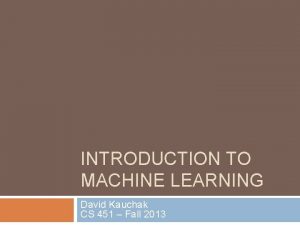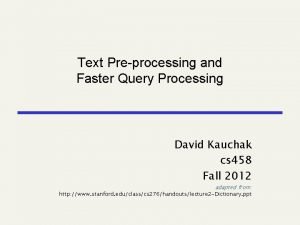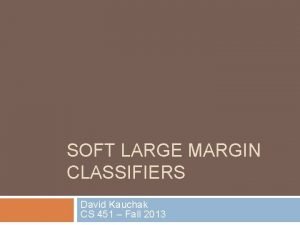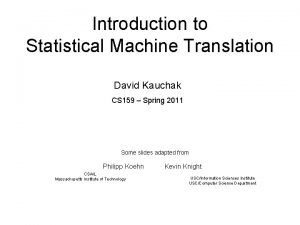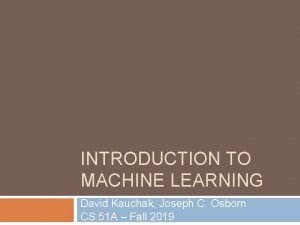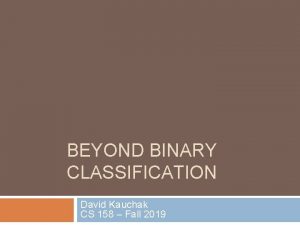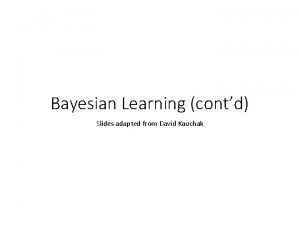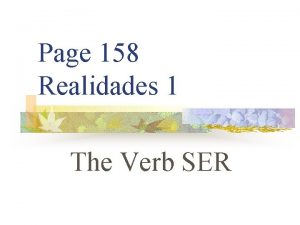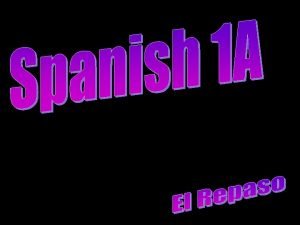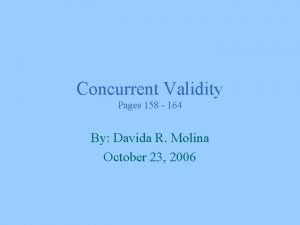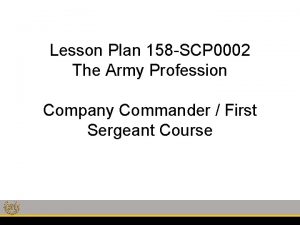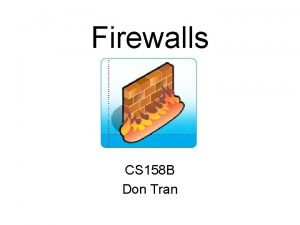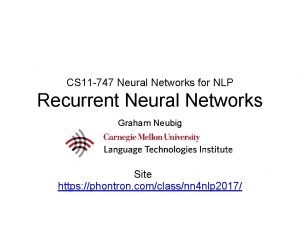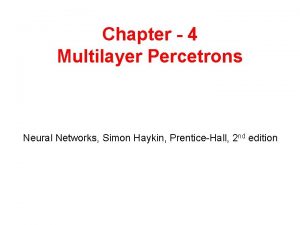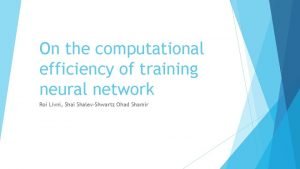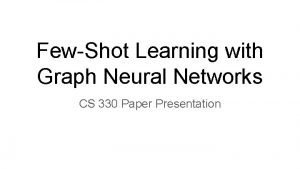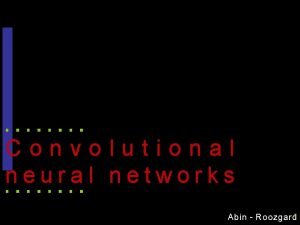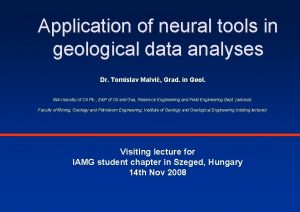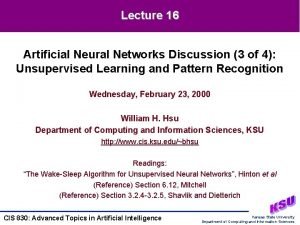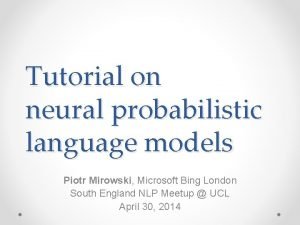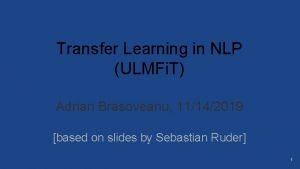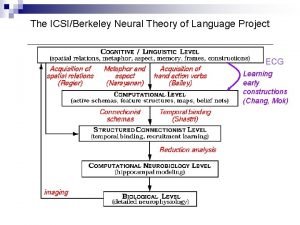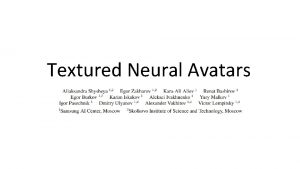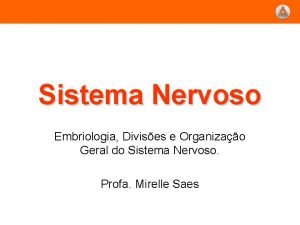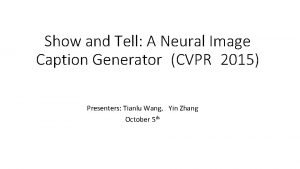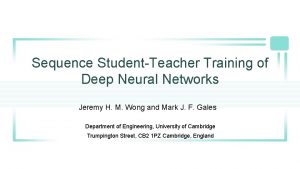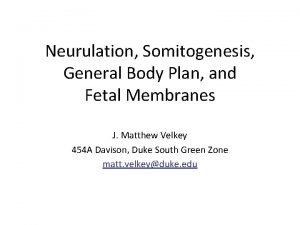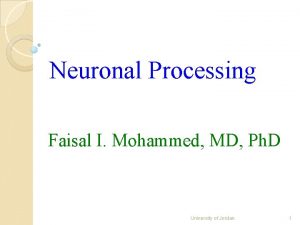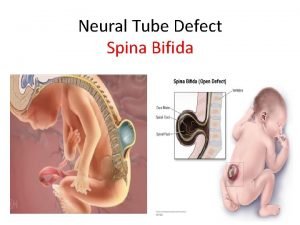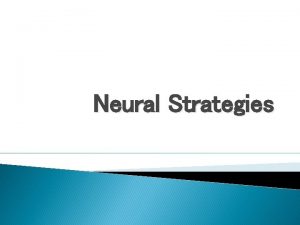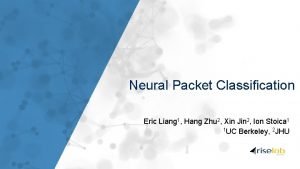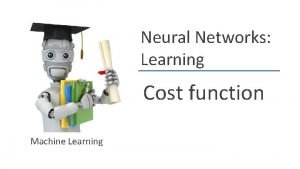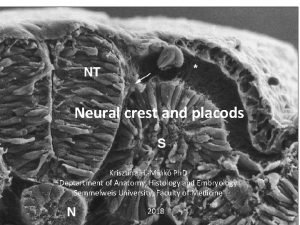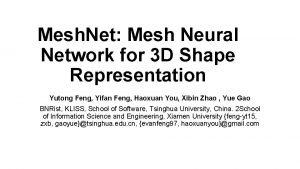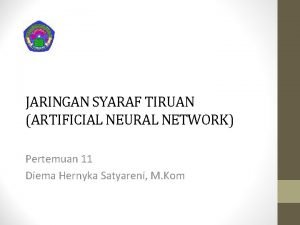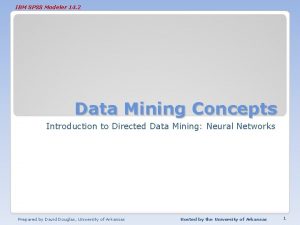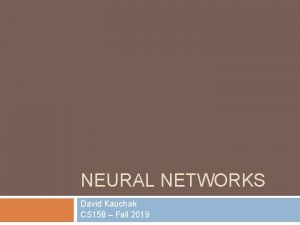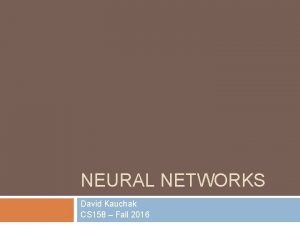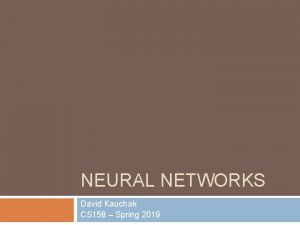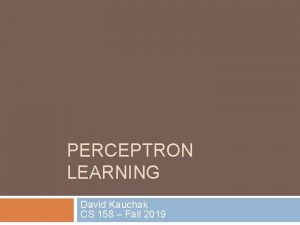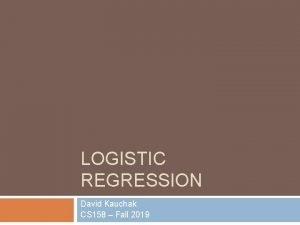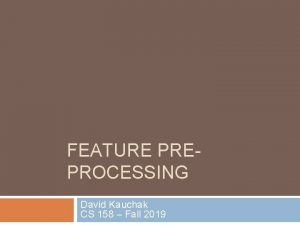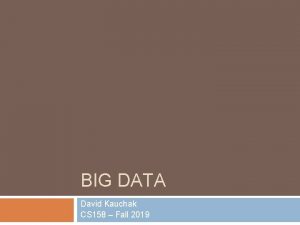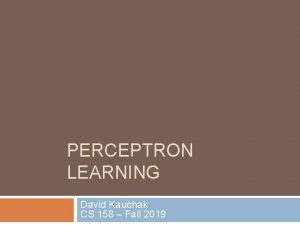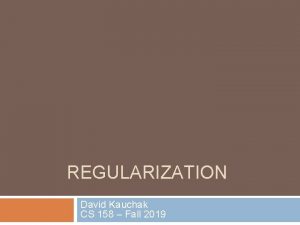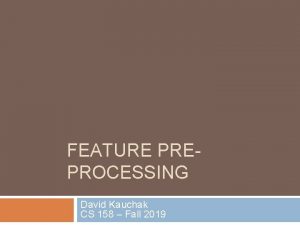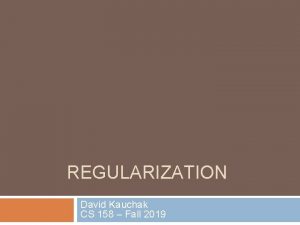NEURAL NETWORKS David Kauchak CS 158 Fall 2019

































































- Slides: 65

NEURAL NETWORKS David Kauchak CS 158 – Fall 2019

Admin Assignment 7 A solutions available on sakai in resources Assignment 7 B Assignment grading

Perceptron learning algorithm repeat until convergence (or for some # of iterations): for each training example (f 1, f 2, …, fn, label): if prediction * label ≤ 0: // they don’t agree for each wi: wi = wi + fi*label b = b + label Why is it called the “perceptron” learning algorithm if what it learns is a line? Why not “line learning” algorithm?

Our Nervous System Neuron What do you know?

Our nervous system: the computer science view the human brain is a large collection of interconnected neurons a NEURON is a brain cell � � � they collect, process, and disseminate electrical signals they are connected via synapses they FIRE depending on the conditions of the neighboring neurons

A neuron/perceptron Input x 1 Weight w 1 Input x 2 Weight w 2 Output y activation function Input x 3 Weight w 4 Input x 4 How is this a linear classifier (i. e.

Hard threshold = linear classifier hard threshold: x 1 x 2 w 1 w 2 … wm xm output

Neural Networks try to mimic the structure and function of our nervous system People like biologically motivated approaches

Artificial Neural Networks Node (Neuron/perceptron) Edge (synapses) our approximation

Node A (perceptron) Weight w Node B (perceptron) W is the strength of signal sent between A and B. If A fires and w is positive, then A stimulates B. If A fires and w is negative, then A inhibits B.

Other activation functions hard threshold: sigmoid tanh x why other threshold functions?

Neural network inputs Individual perceptrons/neur ons

Neural network inputs some inputs are provided/entered

Neural network inputs each perceptron computes and calculates an answer

Neural network inputs those answers become inputs for the next level

Neural network inputs finally get the answer after all levels compute

Activation spread http: //www. youtube. com/watch? v=Yq 7 d 4 ROv. Z 6 I

Computation (assume 0 bias) 0. 5 0 0 0. 5 -1 -0. 5 1 1

Computation -0. 05 -0. 02= -0. 07 0. 05 -1 0. 483 0. 5 0. 03 0. 676 -0. 02 1 0. 483*0. 5+0. 495=0. 7365 1 0. 01 0. 495 -0. 03+0. 01=-0. 02

Neural networks Different kinds/characteristics of networks input s How are these different? inputs

Hidden units/layers inputs hidden units/layer Feed forward networks

Hidden units/layers inputs Can have many layers of hidden units of differing sizes … To count the number of layers, you count all but the inputs

Hidden units/layers inputs 2 -layer network 3 -layer network

Alternate ways of visualizing Sometimes the input layer will be drawn with nodes as well inputs 2 -layer network

Multiple outputs input s 0 1 Can be used to model multiclass datasets or more interesting predictors, e. g. images

Multiple outputs input output (edge detection)

Neural networks inputs Recurrent network Output is fed back to input Can support memory! Good for temporal/sequential data

NN decision boundary x 1 x 2 w 1 w 2 … output wm xm What does the decision boundary of a perceptron look like? Line (linear set of weights)

NN decision boundary What does the decision boundary of a 2 -layer network look like Is it linear? What types of things can and can’t it model?

XOR ? Input x 1 ? Output = x 1 xor x 2 ? b=? ? ? ? b=? Input x 2 b=? x 1 0 0 1 x 2 0 1 0 x 1 xor x 2 0 1 1 0

XOR 1 1 Input x 1 Output = x 1 xor x 2 -1 b=-0. 5 -1 1 1 b=-0. 5 Input x 2 b=-0. 5 x 1 0 0 1 x 2 0 1 0 x 1 xor x 2 0 1 1 0

What does the decision boundary look like? 1 1 Input x 1 Output = x 1 xor x 2 -1 b=-0. 5 -1 1 1 b=-0. 5 Input x 2 b=-0. 5 x 1 0 0 1 x 2 0 1 0 x 1 xor x 2 0 1 1 0

What does the decision boundary look like? 1 1 Input x 1 Output = x 1 xor x 2 -1 b=-0. 5 -1 1 1 b=-0. 5 Input x 2 b=-0. 5 What does this perceptron’s decision boundary look like? x 1 0 0 1 x 2 0 1 0 x 1 xor x 2 0 1 1 0

NN decision boundary Input x 1 -1 x 2 (-1, 1) 1 Input x 2 b=-0. 5 x 1 Let x 2 = 0, then: (without the bias)

NN decision boundary Input x 1 -1 x 2 1 Input x 2 b=-0. 5 x 1

What does the decision boundary look like? 1 1 Input x 1 Output = x 1 xor x 2 -1 b=-0. 5 -1 1 1 b=-0. 5 Input x 2 b=-0. 5 What does this perceptron’s decision boundary look like? x 1 0 0 1 x 2 0 1 0 x 1 xor x 2 0 1 1 0

NN decision boundary 1 Input x 1 x 2 b=-0. 5 -1 Input x 2 x 1 Let x 2 = 0, then: (1, -1) (without the bias)

NN decision boundary 1 Input x 1 x 2 b=-0. 5 -1 Input x 2 x 1

What does the decision boundary look like? 1 1 Input x 1 Output = x 1 xor x 2 -1 b=-0. 5 -1 1 1 b=-0. 5 Input x 2 b=-0. 5 What operation does this perceptron perform on the result? x 1 0 0 1 x 2 0 1 0 x 1 xor x 2 0 1 1 0

Fill in the truth table 1 1 b=-0. 5 out 1 out 2 0 0 1 1 0 1 ? ?

OR 1 1 b=-0. 5 out 1 out 2 0 0 1 1 0 1 0 1 1 1

What does the decision boundary look like? 1 1 Input x 1 Output = x 1 xor x 2 -1 b=-0. 5 -1 1 1 b=-0. 5 Input x 2 b=-0. 5 x 1 0 0 1 x 2 0 1 0 x 1 xor x 2 0 1 1 0

1 1 Input x 1 Output = x 1 xor x 2 -1 b=-0. 5 -1 1 b=-0. 5 1 Input x 2 b=-0. 5 x 1

1 1 Input x 1 Output = x 1 xor x 2 -1 b=-0. 5 -1 1 b=-0. 5 1 Input x 2 b=-0. 5 x 1 0 0 1 x 2 0 1 0 x 1 xor x 2 0 1 1 0 x 1

What does the decision boundary look like? Input x 1 Output = x 1 xor x 2 Input x 2 linear splits of the feature space combination of these linear spaces

This decision boundary? ? Input x 1 ? ? Output b=? ? Input x 2 b=?

This decision boundary? Input x 1 1 -1 Output -1 b=-0. 5 -1 1 -1 Input x 2 b=0. 5

This decision boundary? Input x 1 1 -1 Output -1 b=-0. 5 -1 1 -1 Input x 2 b=0. 5

-1 -1 b=0. 5 out 1 out 2 0 0 1 1 0 1 ? ?

NOR -1 -1 b=0. 5 out 1 out 2 0 0 1 1 0 0 0

What does the decision boundary look like? Input x 1 Output = x 1 xor x 2 Input x 2 linear splits of the feature combination of these linear spaces

Three hidden nodes

NN decision boundaries ‘Or, in colloquial terms “two-layer networks can approximate any function. ”’

NN decision boundaries For DT, as the tree gets larger, the model gets more complex The same is true for neural networks: more hidden nodes = more complexity Adding more layers adds even more complexity (and much more quickly) Good rule of thumb: number of examples number of 2 -layer hidden nodes ≤ number of dimensions

Training ? Input x 1 ? Output = x 1 xor x 2 ? b=? ? ? ? b=? Input x 2 b=? How do we learn the weights? x 1 0 0 1 x 2 0 1 0 x 1 xor x 2 0 1 1 0

Training multilayer networks perceptron learning: if the perceptron’s output is different than the expected output, update the weights gradient descent: compare output to label and adjust based on loss function Any other problem with these for general NNs? w w w perceptron/ linear model neural network

Learning in multilayer networks Challenge: for multilayer networks, we don’t know what the expected output/error is for the internal nodes! how do we learn these weights? w w ww w w expected output? w w w perceptron/ linear model neural network

Backpropagation: intuition Gradient descent method for learning weights by optimizing a loss function 1. 2. 3. calculate output of all nodes calculate the weights for the output layer based on the error “backpropagate” errors through hidden layers

Backpropagation: intuition We can calculate the actual error here

Backpropagation: intuition Key idea: propagate the error back to this layer

Backpropagation: intuition “backpropagate” the error: Assume all of these nodes were responsible for some of the error How can we figure out how much they were responsible for?

Backpropagation: intuition w 1 w 2 w 3 error for node is ~ wi * error

Backpropagation: intuition w 4 w 5 w 6 w 3 * error Calculate as normal using this as the error

Backpropagation: the details Gradient descent method for learning weights by optimizing a loss function 1. 2. 3. calculate output of all nodes calculate the updates directly for the output layer “backpropagate” errors through hidden layers What loss function?

Backpropagation: the details Gradient descent method for learning weights by optimizing a loss function 1. 2. 3. calculate output of all nodes calculate the updates directly for the output layer “backpropagate” errors through hidden layers squared error
 David kauchak
David kauchak Lebensversicherungsgesellschaftsangestellter
Lebensversicherungsgesellschaftsangestellter David kauchak
David kauchak Translation process
Translation process David kauchak
David kauchak David kauchak
David kauchak David kauchak
David kauchak Introduction to teaching: becoming a professional
Introduction to teaching: becoming a professional The verb ser (p. 158) answers
The verb ser (p. 158) answers Krs 158
Krs 158 Me gustan me encantan (p. 135)
Me gustan me encantan (p. 135) Concurrent validity example
Concurrent validity example Scp 158
Scp 158 Cs 158
Cs 158 Visualizing and understanding convolutional neural networks
Visualizing and understanding convolutional neural networks Liran szlak
Liran szlak Ib psychology
Ib psychology Audio super resolution using neural networks
Audio super resolution using neural networks Convolutional neural networks for visual recognition
Convolutional neural networks for visual recognition Leon gatys
Leon gatys Efficient processing of deep neural networks pdf
Efficient processing of deep neural networks pdf Deep neural networks and mixed integer linear optimization
Deep neural networks and mixed integer linear optimization Convolutional neural network presentation
Convolutional neural network presentation Neural networks and learning machines 3rd edition
Neural networks and learning machines 3rd edition Pixelrnn
Pixelrnn Matlab neural network toolbox pdf
Matlab neural network toolbox pdf Neural networks for rf and microwave design
Neural networks for rf and microwave design 11-747 neural networks for nlp
11-747 neural networks for nlp Neural networks simon haykin
Neural networks simon haykin Csrmm
Csrmm On the computational efficiency of training neural networks
On the computational efficiency of training neural networks Tlu in neural network
Tlu in neural network Neural networks and fuzzy logic
Neural networks and fuzzy logic Introduction to convolutional neural networks
Introduction to convolutional neural networks Convolutional neural networks
Convolutional neural networks Few shot learning with graph neural networks
Few shot learning with graph neural networks Deep forest towards an alternative to deep neural networks
Deep forest towards an alternative to deep neural networks Convolutional neural networks
Convolutional neural networks Neuraltools neural networks
Neuraltools neural networks Gated recurrent unit in deep learning
Gated recurrent unit in deep learning Predicting nba games using neural networks
Predicting nba games using neural networks Neural networks and learning machines
Neural networks and learning machines The wake-sleep algorithm for unsupervised neural networks
The wake-sleep algorithm for unsupervised neural networks Audio super resolution using neural networks
Audio super resolution using neural networks Convolutional neural network alternatives
Convolutional neural network alternatives Datagram network vs virtual circuit network
Datagram network vs virtual circuit network Backbone networks in computer networks
Backbone networks in computer networks A neural probabilistic language model
A neural probabilistic language model улмфи
улмфи Cervical and brachial plexus
Cervical and brachial plexus Neural theory
Neural theory Textured neural avatars
Textured neural avatars Prosencéfalo mesencéfalo e rombencéfalo
Prosencéfalo mesencéfalo e rombencéfalo Show and tell: a neural image caption generator
Show and tell: a neural image caption generator Student teacher deep learning
Student teacher deep learning Splanchnic mesoderm
Splanchnic mesoderm Neural circuits the organization of neuronal pools
Neural circuits the organization of neuronal pools What is neural tube
What is neural tube Neural strategies pdhpe
Neural strategies pdhpe Neural packet classification
Neural packet classification Cost function neural network
Cost function neural network Mink ph reviews
Mink ph reviews Meshnet: mesh neural network for 3d shape representation
Meshnet: mesh neural network for 3d shape representation Pengertian artificial neural network
Pengertian artificial neural network Neural network in r
Neural network in r Spss neural network
Spss neural network
